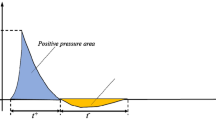Abstract
We have recently obtained many photographs of Mach waves1, known alternatively as ‘bridge’ or ‘Y’ waves2, in the shock wave systems resulting from the detonation of unconfined charges of solid explosive. Waves of this type, which Mach postulated from the observation of soot patterns, are produced when supersonic waves intersect at obtuse angles of incidence. Instead of the simple intersection (which obtains in collisions at acute angles as well as in collisions of sonic waves at any angle of incidence), there is formed a Mach wave which travels in a direction parallel to the plane of symmetry bisecting the angle between the original colliding shock waves.
This is a preview of subscription content, access via your institution
Access options
Subscribe to this journal
Receive 51 print issues and online access
$199.00 per year
only $3.90 per issue
Buy this article
- Purchase on Springer Link
- Instant access to full article PDF
Prices may be subject to local taxes which are calculated during checkout
Similar content being viewed by others
References
Mach, Site. (Wiener) Akad. Wissenschaften, 77, 819 (1878).
McMillen and Harvey, J. Appl. Phys., 17, 541 (1946)
Payman and Woodhead, Proc. Roy. Soc., A, 163, 575 (1937).
Author information
Authors and Affiliations
Rights and permissions
About this article
Cite this article
WOODHEAD, D., WILSON, R. Mach Waves in Shock Wave Systems from Detonating Explosives. Nature 160, 672–673 (1947). https://doi.org/10.1038/160672a0
Issue Date:
DOI: https://doi.org/10.1038/160672a0
Comments
By submitting a comment you agree to abide by our Terms and Community Guidelines. If you find something abusive or that does not comply with our terms or guidelines please flag it as inappropriate.



